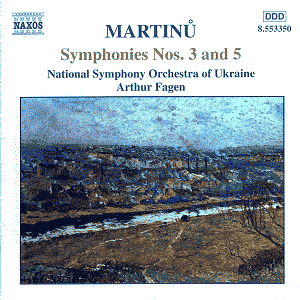This is the final release in Naxos’ Martinu Symphonic
cycle and the first I’ve heard. It’s excellent news that an inexpensive
series exists – the Martinu discography is notoriously changeable –
because this is a body of work that deserves close and consistently
involved scrutiny. In the 3rd Symphony I listened to Ancerl’s
1966 Czech Philharmonic broadcast. There is no comparison in sound –
Ancerl’s is constricted, somewhat muddied and with a cut treble but
one can hear that theirs is a palpably more febrile and spontaneous
opening than Fagen – but unlike the Ukrainian performance Ancerl doesn’t
show all his structural cards at once and the sense of powerful things
being held in reserve is everywhere felt. The Czechs realise the rhythmic
attack in the middle of the first movement with perfect tone and unstoppable
impetus – the off the beat writing and the bassoon’s winding line are
both well brought out by Ancerl, much less well by Fagen – as is the
recapitulation of that remorseless, insistent and obsessive opening
theme; Ancerl’s climax is really blazing. In the tragic largo Fagen
piles on huge dark sonorities – most impressive in its way but emerging
as generic and gestural. Nevertheless it’s good to hear the clarity
of Martinu’s favoured orchestral piano for once. Fagen’s flautist is
straight here with some nice plinking accompaniment whereas Ancerl’s
is in the highest Czech tradition – a vocal and personalized colourist
who brings out the neo-classical elements embedded in the score. It’s
most instructive to contrast the succeeding fugal section; played with
sweeping understanding by Ancerl, for Fagen it is more of a romanticised
interlude, rather inaptly sitting on the fabric of the music – a syntactical
error, I think. The Finale shows equally divergent attitudes. Ancerl
takes 9 ½ minutes, Fagen 11 ½. The Czech conductor takes off at a tremendous
lick, without breathlessness of attack or smudged articulation; he is
vituperative here and evinces consistently more levels of activity and
engagement, as differentiated from mere velocity – this is not a matter
of speed it’s more a question of structural integrity and tempo relation
– at both of which Fagen cannot ultimately compete with Ancerl. The
older man gives full rein to Martinu’s voicings in his bustling orchestral
rhythms. By comparison Fagen is too fitful, too impassive in the face
of the generated tension of Ancerl and insufficiently determined to
delineate Martinu’s multifaceted writing.
What is true of the 3rd is truer of the
5th. Ancerl recorded this commercially and it is in good
sound. In the first movement he shows a much greater sense of rhythmic
impetus and anxious momentum, is crisper and more decisive. He is one
minute quicker in the Larghetto – with commanding angularity of string
and woodwind writing and he’s also wittier than Fagen. Ancerl shows
decisively how Martinu’s neo-classicism can be made to entwine within
the weave of the writing and not exist as some technical imposition
upon it; his "integrationist" expertise is surely unmatched
in this repertoire. Ancerl’s trumpet solo is one of affirmation here
as is the bursting into life of the whole orchestra and his violin solo
emerges "in the balance" – and not wiry and tremulous as is
Fagen’s. Ancerl’s figuration is clearer, Fagen’s rhythms less taut.
In the final movement it is Fagen who is distinctly quicker. He employs
a subtle range of dynamics here, well caught by the engineers, and is
excellent at bringing out the composer’s bluffness, especially in the
transition passage to the allegro but there is never quite as much fresh
air in his performance as there is in Ancerl’s; it sounds rather more
earthbound. String tone, despite recorded quality, is also in the Czechs’
favour – but Fagen ends well, capturing the rather abrupt and disconcerting
conclusion with real understanding.
Comparing Ancerl with Fagen is decisively to the former’s
advantage but this is not to suggest that Fagen’s is a negligible account.
His is a cogent and cohesive traversal of these symphonies – only the
very greatest performances could withstand close scrutiny with Ancerl’s
and if Fagen falls in this regard then he is in good company. Fagen
is a sensitive and sensible guide – these are certainly not shattering
accounts but they are more than merely worthwhile.
Jonathan Woolf


